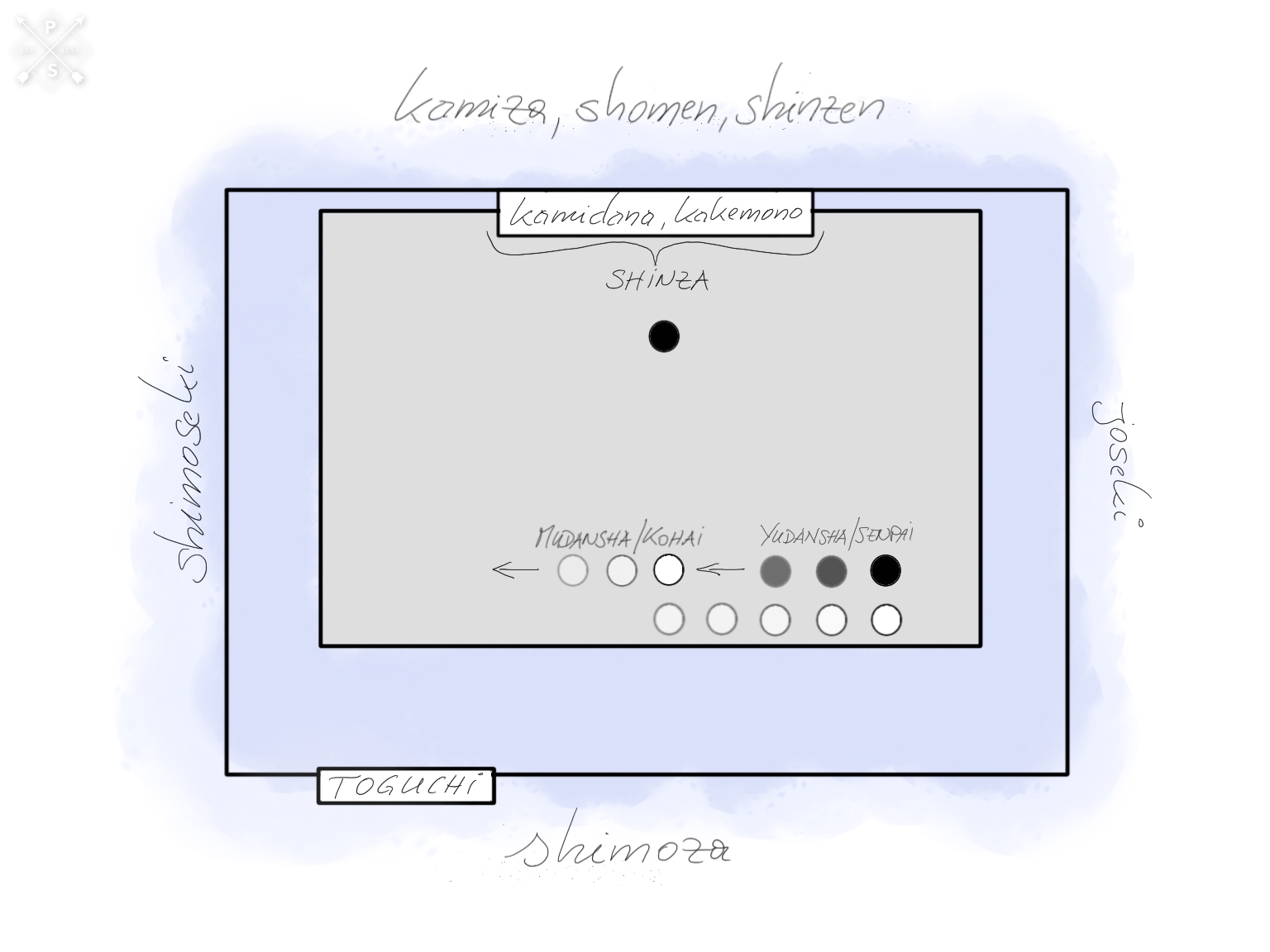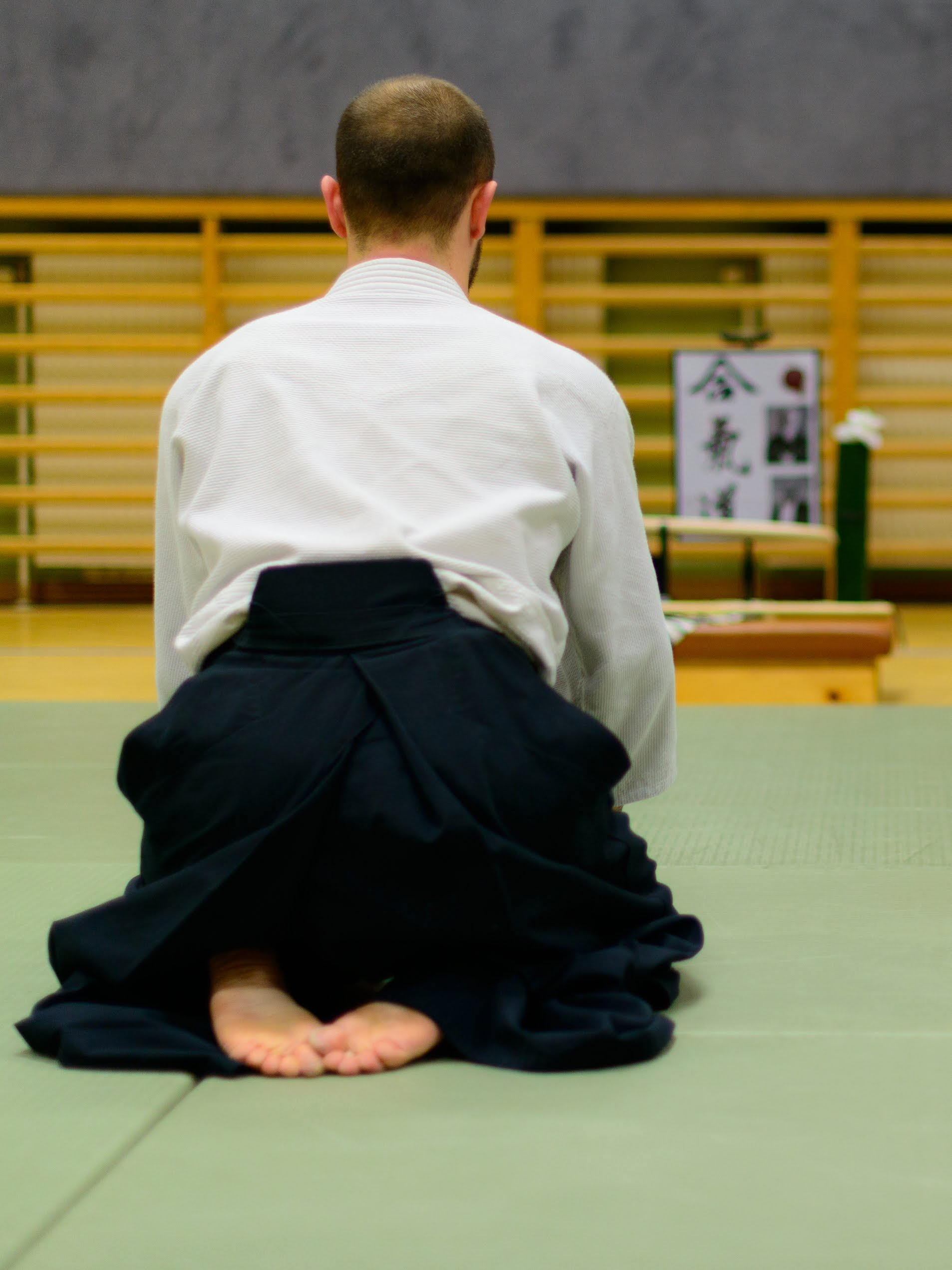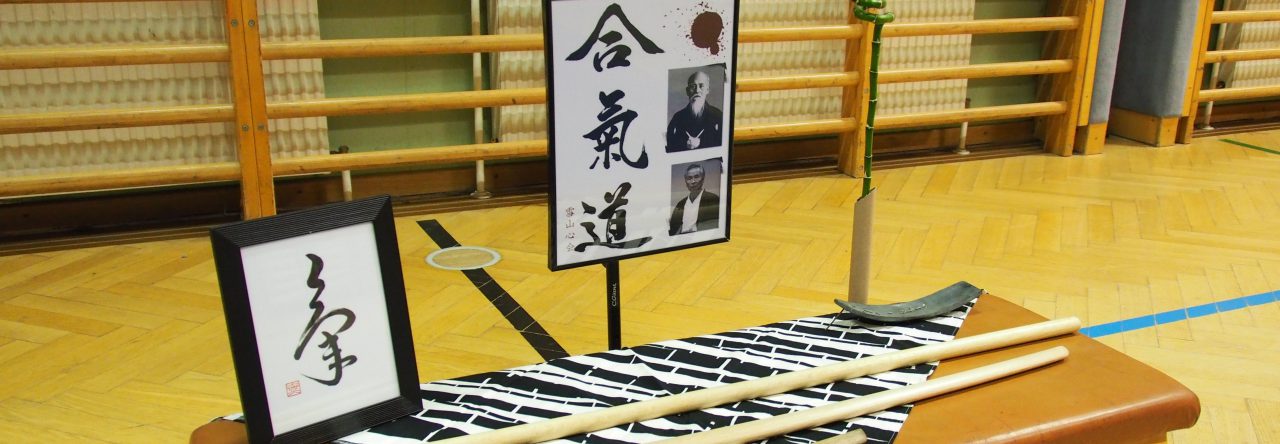About entering, leaving the dojo and proper etiquette
To mark the start of the semester, here is a little dojo theory for you to read and remind. This step-by-step guide describes in broad terms how to enter and leave a (or our) dojo, how to get on and off the mat, and what proper behavior during reishiki and during training is all about …

In order to clarify the confusion surrounding terminology, here are some essential terms to help you find your way around a dojo:
- shinza (神座): spiritual place, location of a shrine
- kamiza (神座): literally ‘seat of God/the gods’, also place of honour (e.g. for high-ranking individuals and guests, opposite shimoza); related to shinzen
- shinzen (神前): before God, before a sacred place, usually where a shrine is located, related to kamiza.
- shomen (正面): front side, honourable side, where kamiza and kamidana are located Note: kamiza and shomen are ideally facing north
- kamidana (神棚): shrine
- kakemono (掛け物): scroll, calligraphy
- shimoseki (下席): lower side, place of (ungraded) students
- joseki (上席): upper side, place of advanced students/graduates/teachers
- shimoza (下座): lower seat, lower place, opposite kamiza (ideally facing south)
- toguchi (戸口): entrance (to the dojo), usually on the shimoza side; also mon (門): door
Classic floor plan of a dojo:

The path from the door to the mat
1.
Training clothes (keiko gi), including hakama if applicable, should be neatly arranged, the belt (obi) should be tied properly, and sandals (zori) or equivalent footwear should be worn. When coming from the changing area and entering the actual training room (dojo or gym), all items brought with you (weapon bag, rucksack, sports bag, etc.) should first be placed carefully and quietly next to you.
2.
Then, standing facing shomen (or kamiza, if already present), bow deeply and clearly towards shomen or kamiza. You should stand either with your feet shoulder-width apart (shizentai) or with your heels together and your toes pointing forward at an angle of about 45 degrees. Your arms and hands should be at your sides or on your hips.
In some dojos (such as ours), you also clap your hands twice at chest height in a clearly audible manner before bowing. The purpose of this is, on the one hand, to positively attune spiritual powers for the upcoming training session; on the other hand, there is a practical aspect to this action, which is to draw attention to your arrival so that the teacher and the other people present notice you.
3.
If the mat area has not yet been prepared, place any equipment you have brought with you in a safe place (mobile phones switched off!) and secure it to the wall opposite the kamiza (this side is called shimoza); even at this stage, you should ensure that these items are positioned appropriately according to your training level, rank, etc. (see excursus: Where am I supposed to be?). Then help with the preparations if necessary. Follow the lead of those who are ‘at home’ there or those who are in charge (e.g. of a course). In any case, it is important to lay out the mats first and only then, as a final step, prepare the kamiza (unless it is permanently installed on site).
Digression: Where am I right?
Students (deshi) who are already advanced, i.e. graduated (at least 1st dan/shodan) (yudansha; 有段者), as well as those who are generally regarded as senpai (simplified: older, more experienced; 先輩) always tend to sit on the joseki side of the dojo, while the less experienced, ‘younger’ students (kohai; 後輩) or ungraded beginners (mudansha; 無段者) tend to sit on the opposite side (shimoseki) in descending order of rank. This also applies to the areas at the edge of the mat when entering/leaving; kohai and mudansha tend to do so at shimoseki, while senpai and yudansha tend to do so at joseki.
How to step onto the mat area
1.
Once the dojo or mat area has been prepared, as well as the kamiza, you should gather the items you need for training, which are usually your weapons (bag). Still wearing your zori, step to the edge of the mat area on the shimoza side and place your equipment there. Depending on the space available, the weapons can be placed parallel (if there is plenty of space) or perpendicular to the edge of the mat. It is important to note that the tip and cutting edge should always point away from the shinzen/kamiza or the centre of the mat area.
2.
Now stand with your toes at the edge of the mat, slip out of your zori and step onto the mat barefoot. Turn towards shinzen/kamiza and change to a kneeling position (seiza).
Caution: Always take great care not to step over discarded weapons, whether your own or those of others. This is considered disrespectful.
Note: If you need to step onto the mat with weapons (tanto, bokken, jo), place them to your right while seated. The tips of the tanto and jo should point backwards (away from shomen), with the blades facing your body – the tanto should be placed closest to you, followed by the bokken and jo furthest away. All weapons should be aligned with your knees.
After a moment of contemplation, bow deeply towards the shomen/kamiza, touching the mat with both palms at the same time. As you stand up, release the contact between your hands and the mat.
3.
Still in seiza, turn to the side (without turning your back to shinzen/kamiza) and rotate your zori 180 degrees so that the heel side is now resting on the edge of the mat (the reason for this is so that the zori are already facing the right way when you leave the mat later).
4.
Now you first place one foot on the mat and then stand up (without supporting yourself on your knee). Until the reishiki (see below), the bowing ceremony that officially opens and closes each training session, you can now move freely on the mat and warm up individually.
Digression on being late
Although this should never be the norm, it can happen that you are late for training. In this case, you should proceed as usual, but wait at the edge of the mat area until you receive a signal from sensei before stepping on the mat. If reishiki is taking place, however, you should refrain from any activity until the ceremony is over.

(c) Tiefenscharffotografie/Sebastian Räuchle
Preparation for reishiki
rei (礼): bow, etiquette, ritual
shiki (式): ceremony
reishiki (礼式): set of rules of conduct or, to put it simply, bowing ceremony
Reishiki is announced in various ways. In everyday training, sensei usually moves visibly from either shimoza or joseki to a position between kamiza and shimoza, facing shimoza. He sits in seiza in front of or close to kamiza.
Attentive attendees should not overlook this; senpai in particular are encouraged to form one or more rows on the shimoza side of the mat, facing kamiza, before sensei has even begun to make his way to his seat.
Here, too, the ranking order must be observed. The participants sit down (ideally according to their dan ranking, starting with the highest-ranked) from joseki downwards towards shimoseki, forming one or more straight rows. The distance between the seated participants should also be approximately the same.
Especially during courses or when there are large numbers of participants, a clearly audible call or clapping may also herald reishiki. Those present now form a line, and as soon as calm has been restored, sensei enters the mat and takes his place.
Reishiki at the beginning
1.
Sensei places his hands in his lap and begins a short period of meditation, gathering his thoughts, settling down on the mat, leaving everyday life behind, etc. The participants follow his example.
2.
Sensei concludes the meditation. With small groups, it is sufficient to move your hands audibly over your hakama; with large groups, you may also hear Sensei give the command ‘rei’.
3.
Sensei now turns towards shomen or kamiza while seated and bows; the deshi do the same. Please note: when bowing towards kamiza, both hands are placed on the floor at the same time.
Note: During reishiki, you may hear the command shomen ni rei or shinzen ni rei, which announces the bow to the honourable side of the dojo, the altar, the shrine, or the seat of the gods/god.
4.
Sensei now turns back to the participants.
5.
Now the participants initiate the following bow to each other, i.e. the senpai takes the initiative here. This is usually the responsibility of the person sitting in the first position on the joseki, i.e. the highest-ranking person after the teacher. Sensei and the participants bow to each other.
Please note: When bowing from person to person, as is the case here, the left hand touches the ground first, followed by the right hand. When standing up again, the right hand slides back onto the lap, followed by the left hand.
The greeting used while bowing is ‘o-negai itashimasu’ (御願い致します) and is considered a polite request for instruction.
Digression:
o-: particle used to emphasise/enhance the word that follows; also used in ‘o-sensei’ (‘great master’)
negai (願い): wish, request, inquiry
itashimasu comes from the verb suru (致す): to do something, to make something; here in the particularly polite written/spoken form.
This concludes reishiki; however, deshi should only stand up or move once sensei has given the appropriate instruction. This is usually followed by a warm-up using aiki taiso, etc.

(c) Tiefenscharffotografie/Sebastian Räuchle
Reishiki at the end of training
After the last training sequence, there may be another short block of aiki taiso to allow calm to return for reishiki, depending on the intensity of the previous exercises. Sensei and the deshi sit down on the mat opposite each other, in the same positions as at the beginning of the session. This is followed by another meditation phase, then a bow to shomen/kamiza and then to each other.
The formula for saying goodbye during the second bow is ‘domo arigato gozaimashita’ (どうも ありがとう ございました), which simply means ‘Thank you very much.’
After bowing – especially in larger seminars – you should wait until sensei has stood up and left the mat. Only then should the senpai stand up, and you can follow suit. In everyday dojo life, the deshi often stand up shortly after or at the same time as sensei, or are given a signal that they may stand up.
The yudansha usually remain on the mat to fold their hakama neatly. All deshi leave the training area again on shimoza, at the point where they entered. Before doing so, they bow once more in seiza towards shomen/kamiza, then slip into the zori that are waiting for them. If you are still carrying weapons at this point (this is the case, for example, when training with bukiwaza has ended), these are placed on the right hand again during the bow (for further details, see note above). While still next to the mat, you stow your weapons in your bag, but continue to take care not to turn your back to shomen.
If the mat area is to be dismantled afterwards, proceed in exactly the opposite order to the beginning: i.e., first dismantle the kamiza respectfully, then remove the mats.
As when entering the room, you place your stored equipment near the door. This is followed by a final bow while standing towards shomen/kamiza (again preceded by clapping twice, if necessary). Then you are done and can leave the training hall.
This article has been published the first time on December 18th, 2018.
References:
Hademitzky, Wolfgang: Kanji und Kana. Die Welt der japanischen Schrift in einem Band.
Krug-Riehl, Hildegard: Tamura, Nobuyoshi. Aikido. Marseille: Eigenverlag/AGEP 1986.
Lernbuch und Lexikon. München: Iudicium Verlag GmbH, 2012.
Taylor, Michael W. (2004): Aikidō terminology. An essential reference…
jisho.org (2018)
wadoku.de (2018)
budopedia.de (2018)
Author’s note: I do not wish my articles to be understood as the final word on the subject, nor do I claim that they are exhaustive. Rather, my aim is to contribute to a coexistence of interpretations and a lively debate on the subject of budo. I would also like to cordially invite all readers to comment, critically question, edit, add to, etc. Thank you very much.